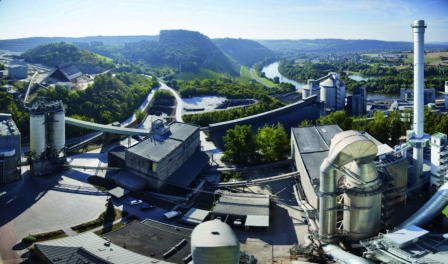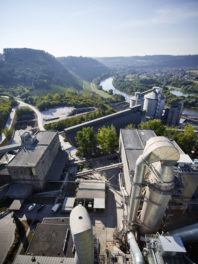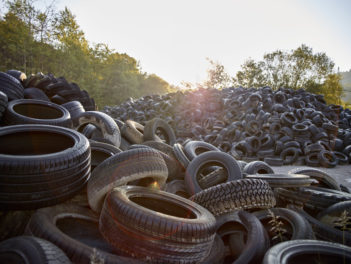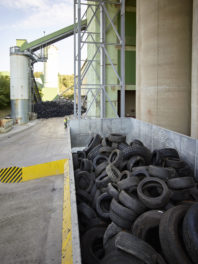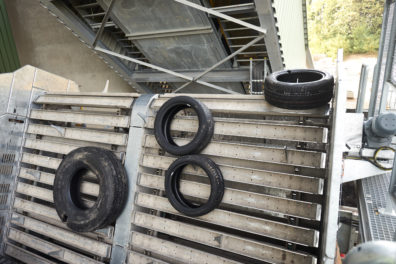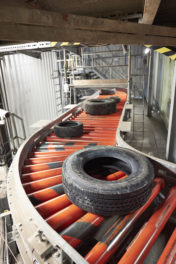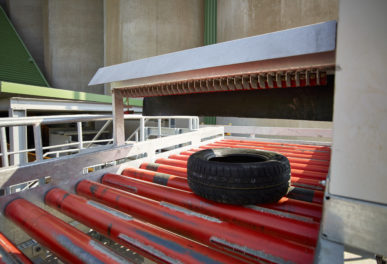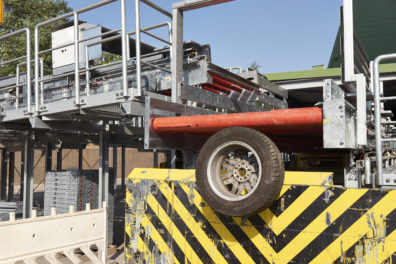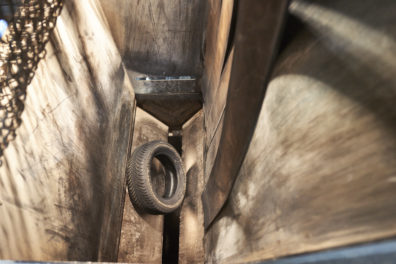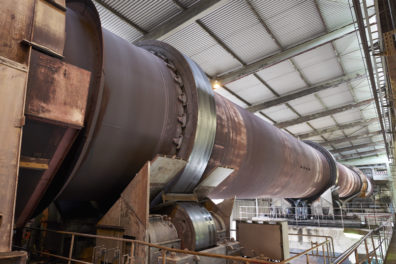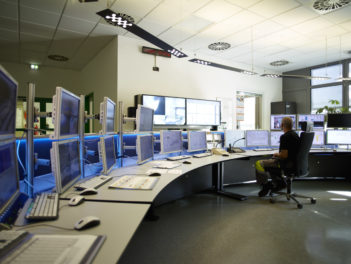BEUMER Group: fully automated tyre transport system at HeidelbergCement ensures continuous feed of waste tyres as secondary fuels
The manufacture of cement is particularly energy-intensive. To reduce the use of valuable primary fuels like coal, HeidelbergCement is opting for alternative fuels, such as waste tyres. The calorific value of rubber is comparable to that of hard coal. And because the iron from the armouring can be incorporated mineralogically into the cement, it reduces the need to add ferrous corrective substances. BEUMER Group supplied the fully-automated system that sorts, separates and regulates the tyres of different sizes and weights and feeds them to the rotary kiln inlet. The system supplier also took over the installation and provided the steel structure. Thanks to the new system, the kiln of the cement plant is now fed with a constant stream of material.
“With every ton of waste tyres that we’re using, we’re replacing the same amount of valuable hard coal,” explains Michael Becker. He is the director of the HeidelbergCement plant in Lengford, a small town in Germany. The company, headquartered in Heidelberg, is one of the largest cement manufacturers world-wide, even a market leader with eight cement and three grinding plants. “Waste tyres have a high heat content, meaning that they are the ideal fuel for our production,” says Becker. About 20,000 tons of hard coal are used in the plant annually to produce circa 20 percent of the overall heat we require, this corresponds to 20 million tyres. “This is how we can substitute the primary fuel with the tyres as secondary fuel,” Becker emphasises.
The tyres that are used are production waste coming from the manufacturers as well as waste tyres from trucks and cars. This also means that they vary greatly: their diameters vary between min. 300 and max. 1,600 millimetres, their widths between 100 and 400 millimetres. The average weight is at eight kilograms for the car tyres and around 60 kilograms for the truck tyres.
Only one system instead of two
To feed the different tyre material to the rotary kiln inlet, HeidelbergCement used to operate two systems: one line transported the smaller and lighter car tyres, the other one the larger and heavier truck tyres. “We didn’t think that this solution was efficient enough,” resumes Becker. “Our employees hung the tyres individually by hand into the hook lift and then transported into the kiln inlet. The heavy truck tyres were handled by an excavator before they were fed into the transport stream. With the new fully automatic system we were able to not only improve this process with regard to occupational safety, but also optimise the working conditions for our employees in combination with an increased performance. We already had a great experience with solutions from BEUMER Group in other plants,” says Becker. “This made it easy for us to opt for the system provider.”
BEUMER Group offers tailor-made systems. Based on wide-ranging experiences and customer requirements, the systems comprise the entire chain, from receiving and unloading the delivery vehicle, up to storing, sampling, conveying and sorting solid alternative fuels. This is why the managers decided for BEUMER Group. “The main requirements on the tyre transport system were a reliable mode of operation for the differently sized tyres, easy maintainability and comprehensive customer support,” explains Becker. And only eight weeks were scheduled to complete installation and commissioning.
From one single source
The first meeting took place in January 2015. As part of the engineering contract a solution was developed and presented by April 2015. “Based on this contract we worked out a quote by July, the contract was awarded at the end of the month and we were able to start at the beginning of August,” says Ralf Lehmkühler, Senior Sales Manager at BEUMER Group. The manager at HeidelbergCement were convinced. Another crucial point, besides the technical details, was the fact that BEUMER Group took over the supply and the installation. “We delivered a feeding and dosing box to feed the wheel loader, hook separators, separating lines for the tyres, a flat belt conveyor with corrugated side walls including a conveyor bridge, a tyre transport system or the preheater tower and a tyre sluice,” reports Lehmkühler. “As well as different checking devices.” The BEUMER Group team started the assembly in February 2016. The experts integrated the electric control system that was provided by the customer and were responsible for the steel structure and the mechanics.
Continuously into the kiln
Wheel loaders slowly take out the waste tyres from the collection point and feed the feeding and sorting box. With a volume of 140 cubic metres, it’s big enough to provide enough material for one shift. It’s equipped with a moving floor: plate fins that are moved by a hydraulic drive transport the waste tyres to the outlet side of the feeding and dosing box. Photocells, mounted at different heights, measure the fill level. When a tyre arrives at the discharge side, it is taken over by the hook separator. It then turns upwards and changes the direction at the drive station. The tyre falls on a roller conveyor. “The hook separator starts operating only when the roller conveyor sends a release signal and the photocell at the hook separator is free,” explains Becker. This prevents the tyres from falling on top of each other. Additionally, they lose any water that might have collected inside the tyre due to the impact when falling on the roller conveyor, and any dirt is removed. A checking device recognizes if the tyres are damaged or if the rims are still on. Those tyres are discharged from the system.
The “good” material is transported from a timing roller conveyor to a flat belt conveyor with corrugated side walls. It provides a separate compartment for each tyre. There is a transfer chute in the discharge area of the conveyor. The tyres are always guided thanks to the design of the chute.
The conveyor transports the combustible material now into the preheater tower. A scale determines the weight of the tyre on the conveyor. The result is registered by the control and evaluated for the feed regulation of the tyres. The tyres enter the tyre sluice through the inlet chute. An arched chute an a guide plate bring the tyres from their horizontal to a vertical position.
The tyres enter the tyre sluice one by one. At the rotary kiln inlet, only one of the flap valves is open at a time to avoid heat losses and flashbacks. “First the upper one opens. Then it closes and the lower flap valve opens,” describes Lehmkühler. The compressed-air tank also ensures that all flaps are closed in case of failure.
Ready for the future
Installation and commissioning were completed within the preset period. The conveying capacity can reach a maximum of three tons per hour, approximately 700 tyres. Thanks to the new system, HeidelbergCement can now feed its kiln with the combustible in a continuous stream and faster than before.
